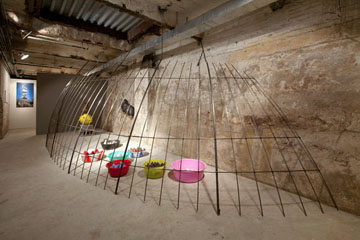
Simone Leigh, "The Gods Must Be Crazy," installation view, 2009. Courtesy Sculpture Center and the Artist.
Simone Leigh is a new world artist/ceramicist of the highest order. Her gnarly yet incredibly beautiful objects and installations provoke, inspire, and remain with you. She works her particular brand of heady and arty mash-up in a fabulous new installation at the Sculpture Center. Our recent email interview about The Gods Must Be Crazy is below.
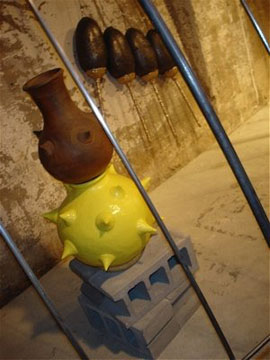
Simone Leigh, "The Gods Must Be Crazy," installation view, 2009. Courtesy Donald Suggs and the Artist.
Kemi Ilesanmi: Simone, your objects carry such an incredible energy as you play with diverse art historical tropes and poke fun at ethnographic blindspots. One of my favorite elements of the installation is the mix of textures, shapes, and sheens—boot prints, shiny points, colorful plastic buckets (so familiar in black and brown spaces), high yellow automotive paint on the pot diptych which sits on lowly cement blocks. How did you approach corralling all this into one installation?
Simone Leigh: I built the entire installation around the archeological term, skeuomorph. A skeuomorph is a derivative object that retains material metaphors and ornaments of original object. Skeuomorphs serve to make the viewer/user more comfortable with the surrogate object by reminding the viewer of the original. My recent work combines my preoccupation with almost obsolete forms, like the terracotta water pot, with more contemporary surrogates like the plastic bucket or the woven bag made in China and used internationally as luggage. In The Gods Must Be Crazy, I incorporate biomorphic objects that I make by hand and recent artifacts, as well as their surrogates. The piece investigates how nostalgia can alter perception and how antecedent meaning is delivered through surrogate forms.
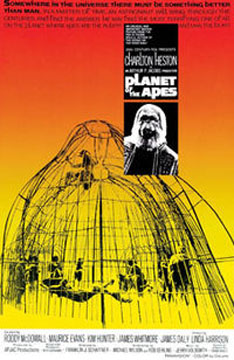
"Planet of the Apes" poster, 1968.
KI: Tell me about the cage. By the way, it appears to have no point of entry, or escape.
SL: I was thinking about the central cage in Planet of the Apes but when I started making drawings I realized it was more like the structure of a Central African teleuk. Probably because I had just become aware of Steven Nelson’s book, From Cameroon to Paris: Mousgoum Architecture In and Out of Africa, that details how these domed structures became a part of the colonial project and therefore became another kind of ethnographic object signaling authenticity. There is a chapter called “The Pineapple in Paris” that discusses the Paris Colonial Exhibition of 1931. I’m very obsessed with this exhibition and artifacts from it often inform my work.
KI: I love the installation’s title The Gods Must Be Crazy. What drew you to that as well as the snippet of Planet of the Apes that you use as an entry point into the installation? What does working in video, often with appropriated footage, allow you do that appeals differently than the objects that you make?
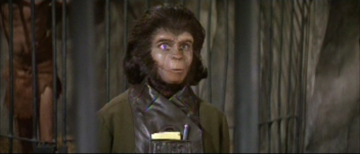
"Planet of the Apes" film still, 1968
SL: I think that both films are science fiction and are out of time. And I enjoy the way science fiction always makes thinking about the location of culture and the formation of identity more obvious. In this installation, the video portrait is of Zira, the heroine of Planet of the Apes who is an ape surrogate for a woman. Her racial identity is unclear. In the film, she talks like a woman and acts like a woman. However, in this brief artifact of the film, she smiles like an ape. She’s giving ape realness. At several moments in the film the action is stopped and the “true nature” of the apes is reminded through some gesture. Verisimilitude, essentialism and female subjectivity are at issue in the video as well as the sculpture.
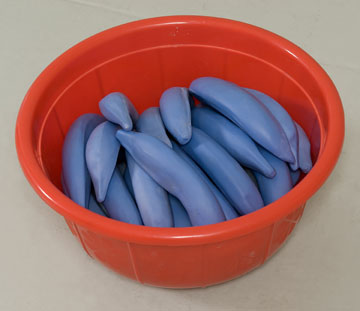
"Wedgewood Bucket," mixed media, 2009. Courtesy the Artist.
KI: On the other hand, why make things, i.e. use your hands and your body to produce objects?
SL: I often think of the sculpture as performative. Performing “women’s work” is one sense. But also I think a lot about the narrative that allows an object to come to be considered ethnographic and not art is often it’s handmade quality. Loss of authorship is also important. I have spent a lot of time researching exactly how these objects are made and I try to make them in that way. So, in another sense, I’m also performing the work of the “anonymous African potter” (oftentimes a woman). So the hand making of objects is necessary for me conceptually. Besides, I like the way it looks.
KI: What else is coming up on your busy summer agenda?
SL: I am installing this week at the Bronx Museum for AIM 29. Micaela Giovannotti is the curator. I’m making new work for a group show at Lisa Cooley in July called The Pleasure of Hating. David Hunt is the curator.
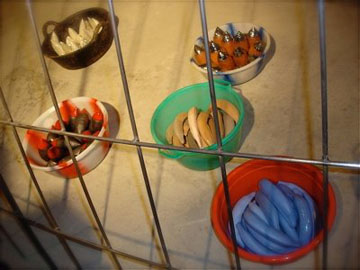
Simone Leigh, "The Gods Must Be Crazy," installation view, 2009. Courtesy Donald Suggs & the Artist.
KI: Thank you, Simone!
The Gods Must Be Crazy, part of the “In Practice” series, is on view at Sculpture Center until August 3, 2009.




Pingback: Art Exhibition: The Studio Museum’s “Evidence of Accumulation” « Repeating Islands